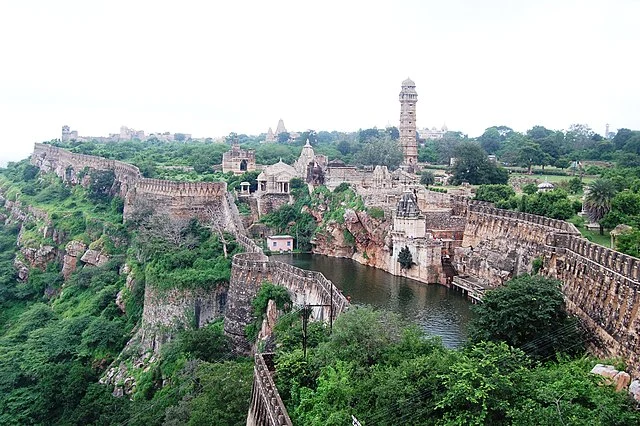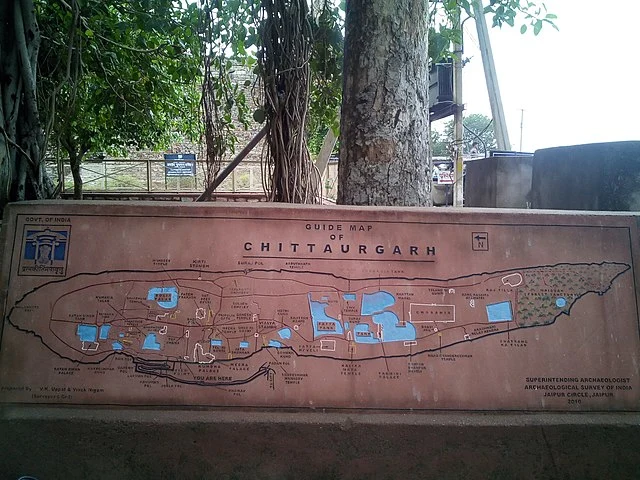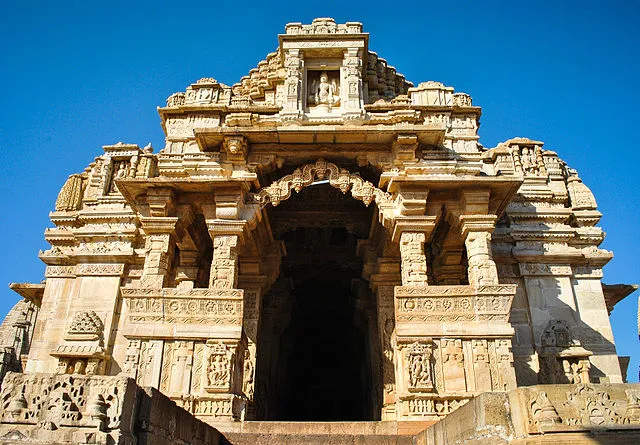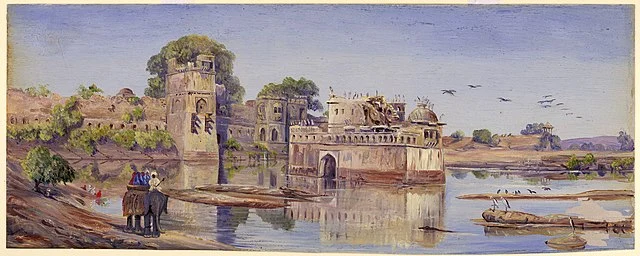Chittorgarh Fort: Discover the rich history and cultural heritage of the Chittorgarh Fort through this article, which offers a combination of historical narrative and Q&A format. Explore its architecture, defense structures, and cultural traditions, and learn about the challenges faced by the fort over the centuries, as well as the ongoing efforts to preserve and restore it for future generations.

The Chittorgarh Fort has a rich and complex history that spans over a millennium. The fort was founded in the 7th century by the Maurya dynasty, but it wasn’t until the 8th century that it gained significant prominence under the Mewar dynasty. Over the centuries, the fort was expanded and renovated by various rulers, each leaving its own unique mark on the complex.
One of the most significant periods in the fort’s history was during the 14th century, when the Rajput ruler Rana Kumbha oversaw extensive renovations to the fort, adding new structures and improving its defenses. Under Rana Kumbha’s leadership, the fort became a hub of art and culture, with numerous temples, palaces, and public buildings being constructed within its walls.
Today, the Chittorgarh Fort is a UNESCO World Heritage Site and a popular tourist destination, with visitors coming from all over the world to marvel at its architectural wonders and learn about its rich history. While the fort has suffered damage over the centuries, ongoing preservation efforts are ensuring that this iconic historical site will continue to stand for generations to come.
The Chittorgarh Fort’s historical significance goes beyond its architectural wonders and tumultuous past. The fort has long been a symbol of Rajput pride and resistance against foreign invaders, and its stories of valor and sacrifice continue to inspire people to this day.
One of the most famous legends associated with the fort is the story of Rani Padmini. According to the legend, Rani Padmini was a queen renowned for her beauty and intelligence. When the Mughal emperor Alauddin Khalji besieged the fort, he became obsessed with possessing Rani Padmini. The queen and her companions, however, chose to perform jauhar, a practice where women would choose to immolate themselves rather than be captured or subjected to the conquerors’ will. The Rajputs then rode out to battle to their deaths.
You Can Read More About Rawal Ratan Singh: The Brave Warrior Who Fought Against Alauddin Khilji Here.

Another legend is that of Panna Dhai, the nursemaid of Maharana Udai Singh II, the founder of Udaipur. During a battle, she saved the infant prince’s life by putting him in the cradle and sacrificing her own son in his place.
The fort’s history is also marked by the presence of several prominent rulers, including Rana Kumbha, Rana Sanga, and Maharana Pratap, who fought against the Mughals in the 16th century. Maharana Pratap, in particular, is remembered for his fierce resistance against the Mughals and is considered a folk hero in Rajasthan.
You Can Read More About MAHARANA PRATAP And MAHARANA SANGA.
Despite the challenges it has faced over the centuries, the Chittorgarh Fort remains a symbol of India’s rich cultural heritage and a testament to the ingenuity and creativity of its architects and builders. As one of the largest forts in India, it offers visitors a glimpse into the country’s rich history and is a must-visit for anyone interested in Indian culture and architecture.

What is the significance of the Chittorgarh Fort in Indian history?
The Chittorgarh Fort is one of the most important historical sites in India, having played a crucial role in the country’s past. The fort was the site of numerous battles and conflicts and has been associated with some of the most prominent rulers and leaders in Indian history. It is also a symbol of Rajput pride and resistance against foreign invaders and is considered an enduring monument to Indian heritage and culture.
What are some of the most notable architectural features of the Chittorgarh Fort?
The fort is renowned for its impressive architecture, which includes numerous palaces, temples, and public buildings. Some of the most notable features of the fort include the Vijay Stambh, a towering victory tower that stands over 30 meters tall, and the Kirti Stambh, another impressive tower that is adorned with intricate carvings and sculptures. The fort also boasts several beautiful temples, including the Meera Temple and the Kalika Mata Temple, both of which are renowned for their intricate carvings and stunning architecture.
What is the best way to explore the Chittorgarh Fort?
The fort is a vast complex that covers an area of over 700 acres, so it is best explored on foot or by hiring a guide. Visitors can enter the fort through one of several gates, including the Padan Pol, the Bhairon Pol, and the Hanuman Pol. Some of the must-visit attractions within the fort include the Kumbha Palace, the Rani Padmini Palace, and the Fateh Prakash Palace. It is also worth exploring the various temples and towers within the fort, as well as taking in the stunning views of the surrounding countryside from the fort’s ramparts.
What are some of the most interesting stories associated with the Chittorgarh Fort?
The fort has a rich history that is filled with fascinating stories and legends. Some of the most interesting tales associated with the fort include the legend of Rani Padmini, the story of Panna Dhai, and the heroic resistance of Maharana Pratap against the Mughals. Visitors can learn more about these and other stories by exploring the various monuments and attractions within the fort, or by hiring a guide who can provide additional insight and context.

What is the best time to visit the Chittorgarh Fort?
The best time to visit the Chittorgarh Fort is during the winter months, from October to March when the weather is mild and pleasant. The fort can be visited at any time of the year, but visitors should be prepared for the hot and humid weather during the summer months. It is also worth noting that the fort can get crowded during peak tourist season, so visitors may want to plan their visit accordingly.
Are there any special events or festivals that take place at the Chittorgarh Fort?
Yes, the fort is host to several festivals and events throughout the year, including the Chittorgarh Fort Festival, which takes place in February and celebrates the region’s rich history and culture. The festival features a range of cultural events, including music and dance performances, food stalls, and handicraft exhibitions. Visitors can also witness the traditional Rajasthani martial art of gatka, which is performed by skilled practitioners.
What efforts are being made to preserve the fort today?
There are several ongoing efforts to preserve and restore the Chittorgarh Fort, which is recognized as a UNESCO World Heritage Site. The Archaeological Survey of India (ASI) is responsible for the conservation and maintenance of the fort and has undertaken several restoration projects in recent years, including the repair of the fort’s walls and towers, and the restoration of several of its buildings and monuments. In addition, various private organizations and community groups are working to promote awareness of the fort’s cultural and historical significance and to raise funds for its preservation.
How can students learn more about the Chittorgarh Fort?
Students who are interested in learning more about the Chittorgarh Fort can access a wealth of information online and in print. There are numerous books, articles, and documentaries that explore the fort’s history and significance, as well as a range of online resources, including websites and social media accounts dedicated to the fort. In addition, students can plan a visit to the fort to explore its various attractions and learn more about its past, or attend cultural events and festivals that take place there throughout the year. Finally, students can engage with local organizations and community groups that are working to preserve and promote the fort’s cultural heritage.

How did the fort fall into decline and disrepair?
The Chittorgarh Fort fell into decline and disrepair over the centuries due to a variety of factors, including neglect, natural disasters, and invasions by foreign powers. The fort was repeatedly attacked and conquered by various rulers, including the Mughals, which led to significant damage and destruction of its buildings and infrastructure.
One example of the fort’s decline was during the siege of 1567-68 when the Mughal emperor Akbar attacked and captured the fort after a long and bloody battle. According to historical accounts, Akbar’s forces destroyed many of the fort’s buildings and monuments, including the famous tower of victory (Vijay Stambh), which had been built by the Rajput king Rana Kumbha to commemorate his victory over the Sultan of Malwa in the 15th century. The tower was later rebuilt by the local ruler Maharana Kumbha in the 19th century, but the damage caused by Akbar’s invasion was a significant blow to the fort’s cultural heritage and architectural legacy.
In Summary
In this article, we have explored the history and cultural significance of the Chittorgarh Fort, one of the most iconic landmarks of Rajasthan, India. Through a combination of historical narrative and Q&A format, we have covered various aspects of the fort’s past and present, including its architecture, defense structures, and cultural heritage. We have also discussed the challenges faced by the fort over the centuries, including invasions by foreign powers and natural disasters, and the ongoing efforts to preserve and restore it for future generations.
The Chittorgarh Fort is a testament to the rich history and cultural heritage of Rajasthan and is widely recognized as one of the most important landmarks of India. Its architecture, defense structures, and cultural traditions offer a unique glimpse into the past and serve as a source of inspiration and pride for millions of people around the world. By preserving and promoting the fort’s cultural heritage, we can help ensure that its legacy lives on for generations to come.
For students who are interested in learning more about the Chittorgarh Fort, there are numerous resources available, including books, articles, and online resources.
Some recommended resources are:
- Read Our Other Interesting Articles On Maharana Pratap, Maharana Sanga And Rawal Ratan Singh.
Admit Card Current Affairs History Indian Polity Mock Test Rajasthan job vacancy RAS application Form RAS Bharti RAS Recruitment 2023 Result Vacancy Yojana
